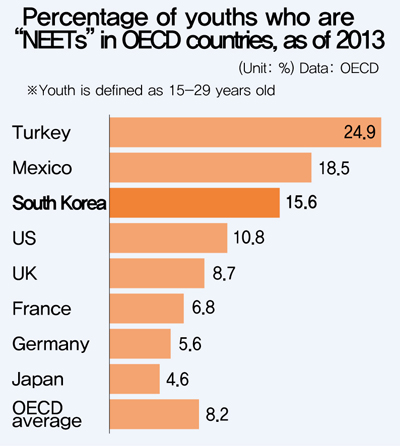South Korea has third most NEETs among developed countries
Many young people in S. Korea have failed to find quality jobs, and therefore lost the motivation to work
South Korea has the third-highest percentage of “NEETs” among the OECD’s thirty-three member countries, recent data show.
The “NEET” label standards for “not in education, employment or training” and refers to young people who do not have a job and are not studying at school or training for employment, indicating that they are not motivated to work.
Data released by the OECD on Aug. 4 showed 15.6% of South Koreans aged 15 to 29 to belong the NEET category in 2013. The number is 7.4 percentage points higher than the OECD average of 8.2%.
The OECD defines NEETs as young people who are not undergoing formal education, are excluded from the labor market, and do not participate in professional training. The only countries in the organization with higher rates than South Korea are Turkey (24.9%) and Mexico (18.5%). Most of the OECD’s most prominent members had significantly lower NEET rates than South Korea, including the US (10.8%), the UK (8.7%), France (6.8%), Germany (5.6%), and Japan (4.6%).
What accounts for the high percentage of NEETs in South Korea? Analysts noted a higher rate of university matriculation than in other countries, along with a growing number of irregular positions and other jobs with poor labor conditions that are reducing young people’s motivation to work.
As recently as the 1990s, only 40% of South Koreans enrolled in university, but since the mid-2000s, the rate has been around 80%, meaning that eight out of 10 South Koreans graduate from university.
With jobseekers’ high level of education making them pickier about jobs and job growth concentrating on irregular jobs, it is increasingly common for people to give up the job hunt altogether.
According to a report called “Characteristics and Implications of NEETs” released by the Hyundai Research Institute (HRI) this past January, 56.2% of NEETs (1.63 million people) had stopped looking for work entirely.
A considerable number of respondents said that they were just spending time at home. There are many cases of NEETs who lack work experience or who had a job before but couldn’t hold it for long.
Among NEETs with work experience, a large number had had a contract job for one year or less (24.6%) or had temporary work (18%). 43% of NEETs were categorized as long-term NEETs, meaning they have been unemployed for at least one year because of the difficulty of getting a job.
“As young people fail to get a job or manage to get one only a low-quality job, there is a tendency for them to stop looking for work or to lose interest in getting a job,” said Kim Gwang-sik, senior analyst at the Hyundai Research Institute.
“South Korea has a high percentage of irregular workers and a comparatively high percentage of NEETs. While youth unemployment rate is lower there than in other countries, the fact that this has been gradually increasing since the end of 2012 is a challenge facing the South Korean labor market,” the OECD also said.
As the OECD suggested, the unemployment rate for South Korean young people is on the rise. While the rate remained between 7% and 9% from 2010 to 2014, this year it has risen into the double digits with 11.1% in February, 10.2% in April, and 10.2% in June.
Young people’s share of the total workforce has also declined from 23.1% in 2000 to 15.1% last year.
“Considering that a substantial percentage of NEETs have left the workforce because of dissatisfaction with working conditions, it is necessary to improve the quality of jobs for young people,” Kim Gwang-sik said.
By Kim So-youn, staff reporter


